For those of you new to The Mimic Method, “Flow-Training” is the technique I use to develop sound mastery in a foreign language. By “Sound Mastery,” I’m referring to the ability to:
- Accurately perceive the nuances of the target language’s sounds, and
- Effortless reproduce those exact same sounds (i.e. speak with good pronunciation).
Hearing and mimicking the sounds of a foreign language will ALWAYS be extremely challenging at first, since the act of speech requires a finely tuned ear and well-trained motor coordination.
The purpose of Flow-Training is to get us through the process of learning a language as quickly and painlessly as possible.
I’ve written about the Flow Training process before, but only in bits and pieces. In this post, I will describe the steps to Flow Training in detail, using my learning of the song “Africain” by Sexion D’assaut as a case study.
No matter what language you’re learning, the steps for Flow-Training will always be the same, so read closely and be sure to leave a comment if you’re unsure about how something applies to your target language.
Let’s get flowin…
Step 1: Hack the Sound System
The very first thing I do when learning a language is wikipedia search “[target language] phonology.” The term “phonology” refers to the study of “sound systems.”
So for example, the wikipedia page on “French Phonology” will tell me most of what I need to know about the sound system of French. Specifically, the answers I’m looking to address are:
- What are all the possible consonant sounds
- What are all the possible vowel sounds
- Which consonant/vowel sounds do NOT exist in any of my current languages.
- Which consonant/vowel sounds am I likely to confuse with sounds I’m already familiar with.
These last two points are what’s most important:
- For every language I learn, there will always be a handful of sounds that are completely new to me.
- Since I’ve never heard or used these sounds before, my ear will probably NOT be able to appreciate them, and my mouth won’t be able to make them properly.
- If any of these sounds are similar (but NOT the same) to sounds I already know, they’re a potential for interference.
This hacking process is extremely important in developing a mental framework of the sounds I’m going to be dealing with. Mastering a foreign sound system will always seem overwhelming to you at first, but as soon as you isolate your the problem areas, the task becomes infinitely more manageable.
Step 2: Choose the Right Songs
Developing hearing sensitivity and speech organ motor memory requires A LOT of attention to detail and repetitive practice. That’s why I primarily Flow-Train with music instead of just random snippets of speech.
The musical meter can put you in the trance state you need to bang out hours of repeated practice, and when you really like the song, the grueling task of dissecting every nuance actually becomes fun and engaging.
When choosing your music, always go for the more rap-like songs within your musical tastes.
By “rap-like,” I mean music that involves fast-paced lyrics that are more spoken than sung. This doesn’t mean it has to be hip-hop. There are plenty of musical genres that use the rapping technique (rapping = rhythmic speaking with little or no melodic pitch variation); it’s just that most people don’t think of this technique as “rapping” unless they hear it in the context of hip hop.
I’ll write more about this in a later post, but the reason rap-like music is superior to melodic singing music for Flow Training is because:
- The faster the lyrics, the more you train your hearing and muscle coordination.
- The faster the lyrics, the more likely they will resemble the realities of normal connected speech.
- Rap-like lyrics focus more on Rhythm – the foundation of speech Flow, as well as Rhyming – the best way to highlight vowel relationships.
It may seem like a better idea to start with slower songs, but as you will see in the next step, the song’s speed is not an issue, since we will be using technology to slow everything down.
Though you definitely can learn a lot from slow melodic music, you’ll always get less Flow from it. Melodic music is slower then normal speech, so there is less of the mashing up of words that happens in normal speech.
Here’s a video of me rapping my very first French song. Note: I still hadn’t studied any french grammar or vocabulary, and at the time that I was singing this, I had no idea what I was saying – the goal was just to get the sounds right.
Step 3: Slow it Down and Transcribe the Syllables
Once you choose your song, procure yourself a digital copy of it, then open the file with the audio-editing software – Audacity (download it for free here).
Audacity works pretty much like a text editor program. When you import a file, there is a “visual waveform” that you can click, select, delete and cut/copy/paste just like a line of text.
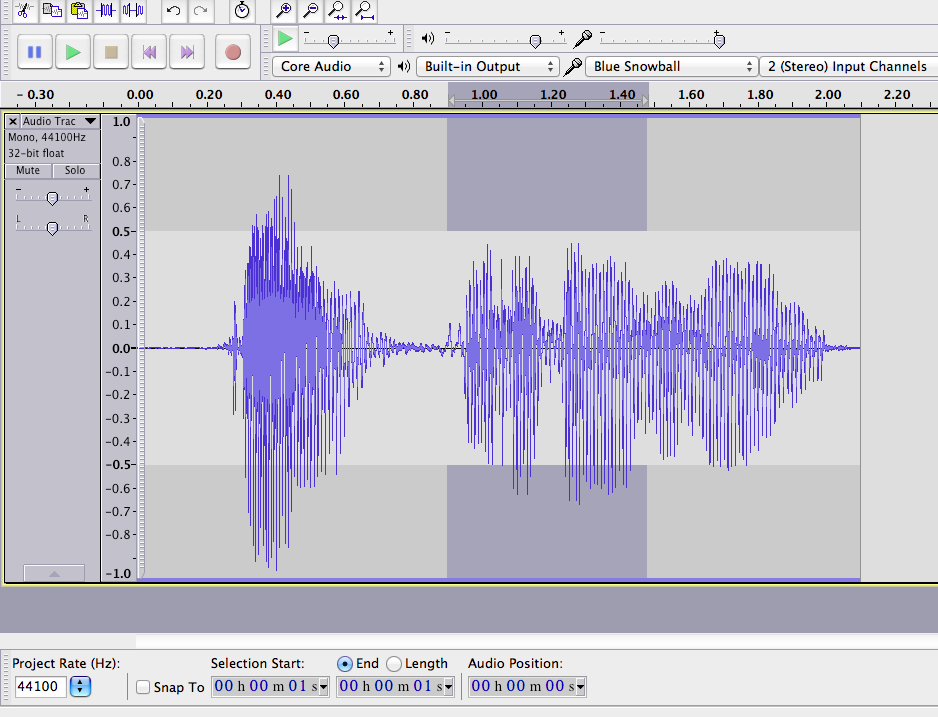
Audacity has a feature that allows you to slow music down while keeping the pitch and everything else constant.
Double-click the wave form or press Ctrl + A to select the entire track, then click Effect –> Change Tempo from the top nav menu. You can then reduce the speed by whatever percentage you want.
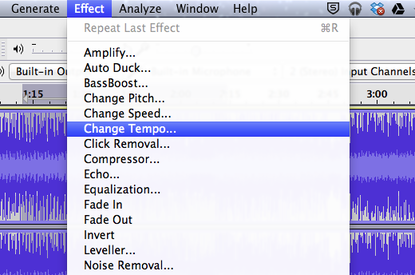
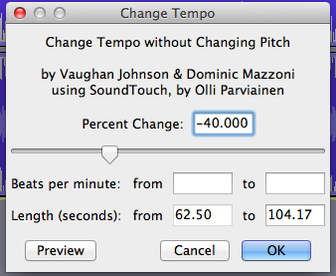
You don’t want to slow it down to much, because at a certain point the sounds will be too distorted. You also want to work with the highest quality audio file you can find, because the less sound that is lost in the digitalization process, the less distorted the reduced tempo sounds will be.
Once you have the track at the speed you want, take out a pencil and paper and try to transcribe each syllable of the section you wish to learn.
When transcribing, you should ideally use the International Phonetic Alphabet and transcribe the syllables according to what you learned during your hacking of the Sound-System.
The reason this is best, is because you don’t want any ambiguity as to what sound is which, and if you use your native or target language spelling system, there WILL be ambiguity and confusion (To learn IPA, I recommend trying out my free e-course – Flow Theory 101.)
When transcribing, do NOT lookup the lyrics and try to transcribe with that. Instead, start by relying solely on your ear.
Reading the written lyrics will distort your perception of the sounds. Best practice is to do it all by ear first, highlight the sounds you weren’t sure about, then after that’s all done, reference the written lyrics for hints to clear up ambiguities.
Here’s my transcription of the chorus from Africain. I’ve included a 40% reduced speed recording of the original song for you to compare.
- a…fχi…kɛ̃
- nə…ʒy…ʒe…pa
- ʃa…ky…mɛ̃…ne…kə…mi…le
- ʒən…sɥi…kɛ̃…na…fχi…kɛ̃
- ʒvø…maʁ…ʃe…søʁ…la…lyn
- me…la…vwe…se…my…mi…lje
- e…tu…le…ʒuʁ…me…fχɛʁ
- mœʁ…paʁ…sɑ̃…tɛ…ne…paʁ…mi…lje
- ʒe…le…ʃəv…kχe…py…
- ʃpu…ʁe…pa…le…go…mi…ne
- il…nu…zɔ̃…di…vi…ze
- puʁ…mjø…nu…do…mi…ne
- il…nu…zɔ̃…se…pa…ʁe
- də…no…fχɛʁ…le…zɑ̃…ti…je
I’m not gonna lie – this process takes a looong time to complete, especially when you’re completely new to the flow of the language.
That’s the whole value proposition behind the Flow Series Courses – I save the student A LOT of time doing all the legwork for them.
I will say, however, that going through this transcription process on your own will do wonders for your perception skills.
Doing this process over and over again to create my courses is how I trained such a keen ear for speech sound.
Step 4: Chop it up and Loop It
Once you are comfortable with your transcription of the sounds, you want to cut the song up along its natural musical breaks. For each line, try to keep it less than 8 syllables (For whatever reason, retention takes a sharp dive after the 8th syllable).
I already showed you how I broke these lyrics down in the transcription above. Now that I know what my breakings are, I want to create separate files for each one and loop the lines multiples times for me to practice with.
First I select the precise moment that I want to start the loop, by zooming in and clicking at that point, then I select a little bit into the second line
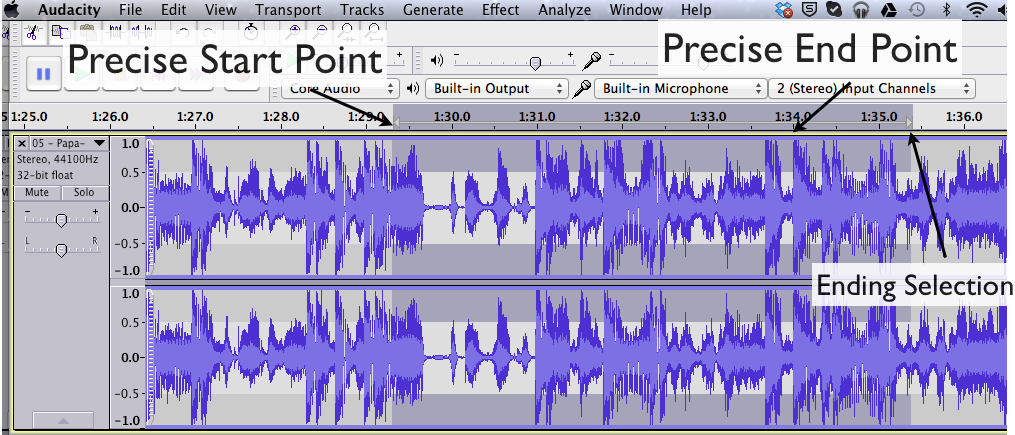
I then Copy this selection and paste it into a new project. Next, I chop off the tail end of the selection I don’t want, copy again, then paste it after.
This usually takes a few tries to get the loop perfectly synced with the musical meter. I need the musical meter to stay in tact, because this allows me to get into that trance where I can focus just on the sound and not worry about timing.
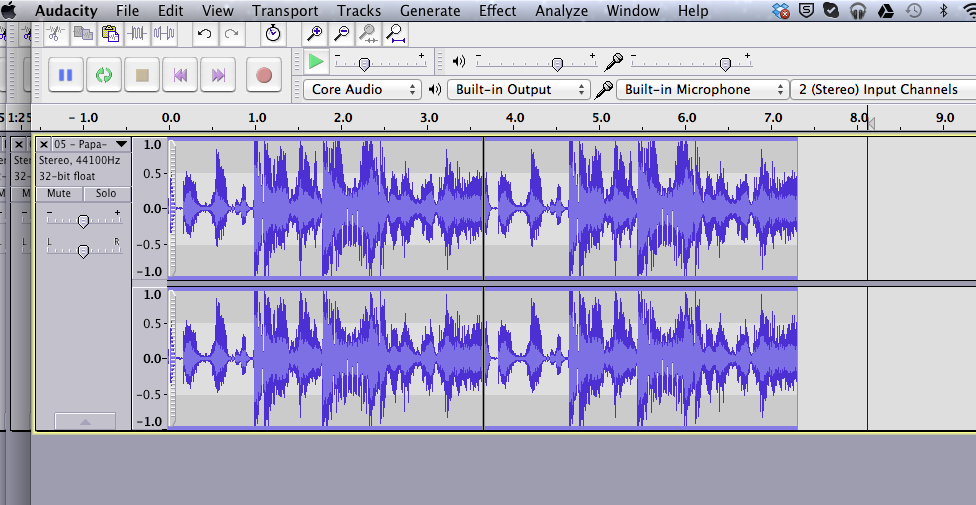
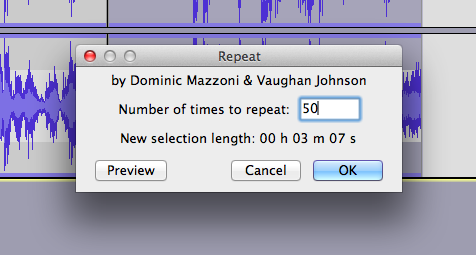
Here’s an example of one of the practice tracks to learn the very first line of the chorus of “Africain”:
Step 5: Memorize It
Like I said, training your ear and mouth to work with new sounds takes A LOT of repetition. That’s why it’s important to commit song lyrics to memory – so you can sing them all the time no matter where you are.
To memorize lines, you use the same Chop & Loop technique to build sections one line at a time until you got the whole lyrics in one recording. Then once you have that memorized, you build the speed back up to full speed.
It takes a few days, but if you practice just an hour a day, you’ll be surprised at how fast you learn. Just make sure you take breaks so that your brain can synthesize the new skills.
Here’s the set I worked with to gradually build my way up to learning the entire chorus.
Step 6: Self Record for Feedback
I can promise you this – you WILL make pronunciation mistakes your first time around. It’s impossible not to.
This of course, is 100% fine as long as you work to eliminate those mistakes, and the only way to do this is to self-record for feedback.
The first way to get feedback is to “Flow-verlap”, which is where you use Audacity to record yourself singing in sync with the original song, then listening to both at the same time to listen for discrepancies.
In the track below, I “Flow-verlap” rap over Sexion D’Assaut.
When flow-training on my own, I have native speakers cloud tutor me.
I take my recording, upload it to Soundcloud.com, share the recording with my native speaking friend, then have them pinpoint the moments that sound “strange” to them.
Here’s my first iteration of Africain with Cloud-Tutoring feedback from a French-native speaking friend (click the track title to view the full comments on soundcloud.com)
This process is extremely useful, as it allows me to pinpoint my personal sticking points.
Once I know the 4 or 5 things I’m doing consistently wrong in the target language, I can narrow my focus not just in the song, but in my speech in general.
This is what separates professionals from amateurs. Amateurs athletes and musicians always practice what they’re already good at, whereas professionals focus all their time shoring up their weaknesses.
Since recording this video, I’ve already learned other French songs, conversed a lot in French and improved my abilities a great deal, so listening to it now I can still hear lots of mistakes, but that’s just part of the learning process.
There’s no limit to how much you can train your flow, and the more flow you got, the better communicator you become in that language. So it’s good to continually strive for perfection in your pronunciation while NOT obsessing over it.
Remember, the goal of flow-training isn’t so much to speak with a “perfect accent” but rather to close the sound divide between you and the native speakers with whom you wish to communicate.
The Shortcomings of Flow-Training
There’s a bit of a paradox to training flow by yourself. When you’re new to a language, there will always be certain sounds and nuances that are literally impossible for you to hear.
Therefore, you can never really rely on any conclusions you come to during the Sound-System Hacking Step, the Lyrics Transcription step, and the Self-Recording feedback step.
I’m continually revising my understanding of the flows I already speak fluently (Including English!). There was a lot of trial and error that went into my development of the Flow-Training, and the process is far from complete.
Sometimes it sucks to have to pioneer this stuff on my own, because the discovery takes up so much of my time and energy. Indeed, entrepreneurs are often inspired by solving their own personal problems, and that’s what inspired my development of The Flow Series.
I just wish I could get future Idahosa to come back in time and drop me off with a USB key of all the Flow-Training materials I need for the future languages I’m going to learn!
I will say, however, that going through all the hard work of figuring it out myself has left me with epic perceptions skills and a profound understanding of Flow.
When I make things easy for you guys with my courses, I sometimes feel bad that I am depriving you of the experience of figuring it out on your own. I can definitely spread the flow to more people by making the process as pain free and accessible as possible, but eventually we’re going to have to train some more flow masters!
Stay tuned and like always – keep on flowin’ my friends 😉
Leave a Reply